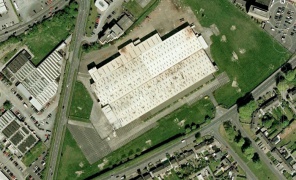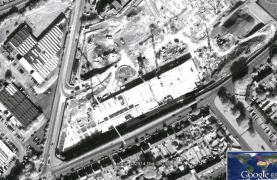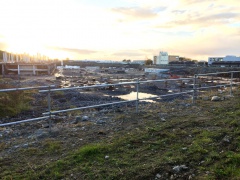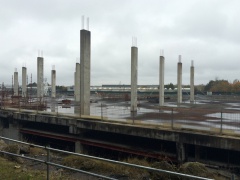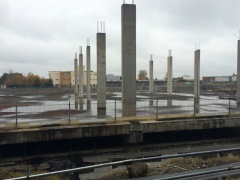Holes: Difference between revisions
Djewesbury (talk | contribs) No edit summary |
Djewesbury (talk | contribs) No edit summary |
||
| Line 10: | Line 10: | ||
Ulster University, formed when the New University of Ulster was merged with the Ulster Polytechnic in 1984, is building a new campus in the centre of Belfast. Courses currently located at its Jordanstown campus, a few miles north-east of the city, will move in when the development is complete. The new building will be on the site of the former Co-operative Stories building, also known as the Orpheus building, which was demolished between 2014 and 2016. | Ulster University, formed when the New University of Ulster was merged with the Ulster Polytechnic in 1984, is building a new campus in the centre of Belfast. Courses currently located at its Jordanstown campus, a few miles north-east of the city, will move in when the development is complete. The new building will be on the site of the former Co-operative Stories building, also known as the Orpheus building, which was demolished between 2014 and 2016. | ||
Building has been delayed because the foundations of the site, which is close to reclaimed land that were once the city's docks, flooded once they were dug. Several underground rivers flow in the area; the water table is also very high, and the local geology is composed of ' | Building has been delayed because the foundations of the site, which is close to reclaimed land that were once the city's docks, flooded once they were dug. Several underground rivers flow in the area; the water table is also very high, and the local geology is composed of 'sleech', a shifting, waterlogged clay, which means that underground watercourses often change their route in unpredictable ways. Digging a hole in the ground can be a risky proposition in such conditions; most developers prefer not to plan extensive sub-floor levels accordingly. | ||
=== The ''Trou des Halles'' === | === The ''Trou des Halles'' === | ||
Revision as of 17:15, 16 November 2016
Holes are the negative space of the city.
A hole is necessarily dug before a building can be erected, as permanent structures need foundations sunk underground to lend them stability. A hole dug deep enough into the ground in an urban site sometimes reveals evidence of previous habitation, and information about the development of the city that serve to disrupt or undermine contemporary understandings of history. Looking deep into holes in the ground can help to call to mind the death of previous incarnations of the city, and to remind the viewer of the dirt and waste that is ordinarily made invisible in the city. Looking deep into holes in the ground can also induce a feeling of vertigo, or a desire to escape; or even a desire to be in a hole deep under the ground.
The new Belfast campus of Ulster University
Ulster University, formed when the New University of Ulster was merged with the Ulster Polytechnic in 1984, is building a new campus in the centre of Belfast. Courses currently located at its Jordanstown campus, a few miles north-east of the city, will move in when the development is complete. The new building will be on the site of the former Co-operative Stories building, also known as the Orpheus building, which was demolished between 2014 and 2016.
Building has been delayed because the foundations of the site, which is close to reclaimed land that were once the city's docks, flooded once they were dug. Several underground rivers flow in the area; the water table is also very high, and the local geology is composed of 'sleech', a shifting, waterlogged clay, which means that underground watercourses often change their route in unpredictable ways. Digging a hole in the ground can be a risky proposition in such conditions; most developers prefer not to plan extensive sub-floor levels accordingly.
The Trou des Halles
Marco Ferreri's 1974 film Touche Pas à la Femme Blanche (Don't Touch the White Woman) is a re-staging of the Battle of Little Big Horn ('Custer's Last Stand') in modern-day Paris. Starring Marcello Mastroianni, Catherine Deneuve and Michel Piccoli, much of the film was shot in a hole in the ground created by the demolition of the old markets at Les Halles and the subsequent deep excavation required for the creation of the Châtelet-Les Halles RER station. The hole was very quickly nicknamed the Trou des Halles or 'hole of the markets'. By using tight camera angles, Ferreri was able to use the steep, sandy banks of the hole to suggest the canyons of the American West. When he panned his camera up, the houses perched on the lip of the hole were revealed, much to the viewer's disorientation.
Images of the continual destruction that characterises the modern city were used by Ferreri to great dramatic effect; throughout the film the greed of the American railroad speculators, and their murderous desire to clear the land at all costs, can clearly be understood as an analogy for contemporary urban clearances. Moreover the casual brutality meted out to the Native Americans is made to stand as a parallel for the USA's involvement in Vietnam at the time of filming. Throughout the film, where reference is made to images of 'the President' (who at the time of the battle, 1876, would have been Ulysses S. Grant) an image of Richard M. Nixon is used.
The Trou des Halles, because of these constant references back and forth across almost exactly a century, comes to seem like a hole to which all the repressions of the city have been consigned, all the most brutal and degraded violent and sexual urges and desires, those things which structure and create the city, but which at all costs can never be acknowledged. Clearly a film very much influenced by Situationist critiques of the urban condition, Touche Pas integrates these with concerns that we could read in terms of Georges Bataille's understandings of 'base materialism'.
The 'hole in the ground' in Galway
The suburb of Mervue lies to the north-east of Galway city. Like the rest of this side of the city beyond the N6 ring road, Mervue is a spatial chaos of retail parks, industrial estates, business units, and older and more recent housing developments. Along the Monivea Road in Mervue is a large development site on which no work has been done since 2008 [1].
Between 1960 and 2006, the site was a factory making, amongst other things, pallet trucks [2]. The factory was owned by Crown, a company headquartered in Ohio, who closed their Galway plant in 2006 and relocated to China [3].
Work begun on the site soon after the Crown plant closed, with ownership transferred to developers Stephen Harris, Walter King and Bernard McKeon and planning applications lodged in early 2006 [4]. McKeown was a former planner for Galway City Council who went into property development during the boom years [5].
The original plans included over 26,000 sq. m of retail space, over 11,500 sq. m of residential space, and over 9,000 sq. m of office and other space. It was envisaged that the project would end up with a value of €400m. Planning was granted in late 2006, but once the Crown plant had been demolished, the developers discovered that the soil in the site was contaminated, and vast quantities had to be removed for treatment. Some foundations had been laid and concrete superstructures had been begun at the time of the financial crash.
In 2010 it was reported that Galway City Council were owed €2.1m in unpaid levies relating to the site, which at this point had transferred into the ownership of Padraic Rhattigan and Stephen Harris [6].
Following the cessation of work on the site, a particularly gifted Galway politician described the site as "a hole in the ground".
Photos of the Mervue Hole in the Ground



